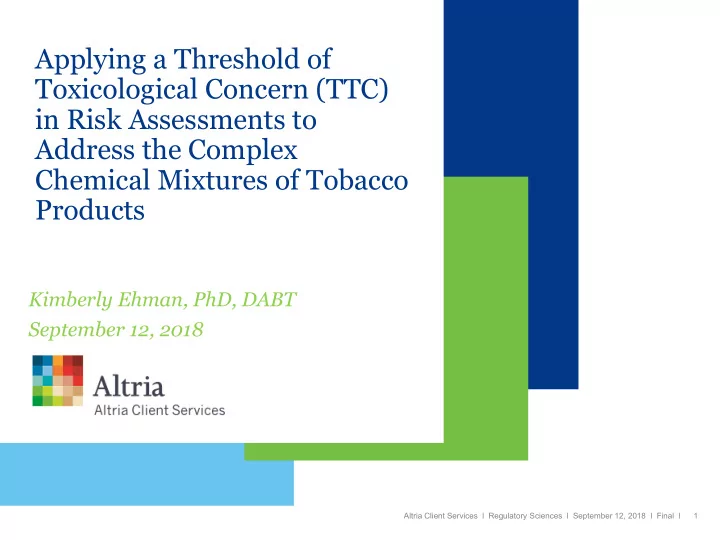

Applying a Threshold of Toxicological Concern (TTC) in Risk Assessments to Address the Complex Chemical Mixtures of Tobacco Products Kimberly Ehman, PhD, DABT September 12, 2018 Altria Client Services l Regulatory Sciences l September 12, 2018 l Final l 1
FDA’s Predictive Toxicology Roadmap Toxicology Issues that Need Addressing for FDA-Regulated Products: - “ Determining comparative toxicity of tobacco products, which are inherently toxic ” Evaluation of new or increased ingredients in the Substantial Equivalence (SE) pathway Promising New Technologies in Predictive Toxicology: - “ Quantitative risk assessment (QRA) addressing the complex mixtures of tobacco products ” Evaluation of GC/LC-MS chemical profile data for e-vapor products in the Premarket Tobacco Product Application (PMTA) pathway Altria Client Services l Regulatory Sciences l September 12, 2018 l Final l 2
Risk Characterization Integration of hazard assessment, dose-response data and exposure assessment to determine likelihood that an identified chemical is going to introduce risk into the exposed population Identification of acceptable daily exposures - Literature search (e.g., IRIS, NTP, ECHA, OECD SIDS, ACGIH) IRIS values (RfC and IUR) Derived acceptable daily exposures Health-based Occupational Exposure Limits (OELs) Threshold of Toxicological Concern (TTC) - Widely accepted across regulated industries: food/beverage, cosmetics, personal care products, medical devices, pharmaceutical impurities Altria Client Services l Regulatory Sciences l September 12, 2018 l Final l 3
TTC Overview: Two Categories Non-genotoxic chemicals - TTCs based on frequency distributions (5 th percentile) of NOEL or NOAEL divided by an uncertainty factor of 100 (Kroes et al ., 2000, 2004) - Cramer Classes: Class I: 1800 µg/day (low toxicity) Class II: 540 µg/day (medium toxicity) Class III: 90 µg/day (high toxicity) - Cramer Class I and III TTCs have been derived using data from inhalation studies (Carthew et al ., 2009; Escher et al ., 2010; Tluczkiewicz et al ., 2016) Genotoxic chemicals - TTC based on predicted tumor risk derived through an analysis of genotoxic chemicals in Carcinogenic Potency Database (CPDB; Gold et al ., 1989) - 1.5 µg/day corresponds to 1 in 100,000 excess lifetime risk of cancer (ICH, 2014) Altria Client Services l Regulatory Sciences l September 12, 2018 l Final l 4
Risk Characterization – Application of an Inhalation TTC TTC is a risk assessment tool based on the principle of establishing a human exposure threshold below which there is a very low probability of appreciable risk to human health (Kroes et al ., 2000 and 2004) 1.5 µg/day is used across regulated industries as an acceptable level for lifetime exposures (70 years) to chemicals, including mutagenic compounds (Kroes et al ., 2004; Munro et al ., 2008; ICH, 2014; ISO, 2017) 1.5 µg/day is applicable to all routes of exposure , including inhalation (ICH, 2014; ISO, 2017) Altria Client Services l Regulatory Sciences l September 12, 2018 l Final l 5
Application in SE Pathway (Cigarettes) Product-specific question related to ingredient added to the New Product Applied conservative exposure assumptions (i.e., 40 cigarettes/day) to several ingredients that were present in the New Product and would result in potential exposure at levels below 1.5 µg/day Compared to TTC of 1.5 µg/day CTP reviewer did not accept use of a TTC of 1.5 µg/day citing: - “ published references provided to support a 1.5 µg/day inhalation TTC were either based on food additives (oral route) and not applicable to tobacco products (e.g., Munro, 1996), or not appropriate for assessing the toxicity of cigarette components (e.g., Tluczkiewicz, 2016, Carthew, 2009)” - “Additionally, the ICH and ISO guidelines cited were not applicable due to the route specific (inhalation) effects of these ingredients…” Altria Client Services l Regulatory Sciences l September 12, 2018 l Final l 6
Application in PMTA Pathway Draft guidance for Electronic Nicotine Delivery Systems (ENDS) products: - Provide adequate information in the PMTA to characterize the constituents in the e-liquid and identify characteristics of the e-liquid that may impact the constituents in the aerosol - Provide stability information, including constituents (HPHCs and other toxic chemicals) over the lifespan of the product Conduct chemical characterization of the device and liquid (GC-MS, LC-MS, ICP- MS) Chemical characterization can generate numerous chemicals for which there are no available toxicological data for risk assessment - A TTC of 1.5 µg/day could be applied – assuming the compounds are potential carcinogens - However, if QSAR analysis indicates that there are no structural alerts for genotoxicity, Cramer Class TTC values derived from inhalation studies should be considered Altria Client Services l Regulatory Sciences l September 12, 2018 l Final l 7
Summary In the absence of tobacco-specific risk assessment guidance, acceptable approaches from other FDA Centers should be considered for tobacco products A TTC of 1.5 µg/day is acceptable for mutagenic drug impurities - all routes of exposure (ICH M7, 2014) and for evaluation of extractable/leachable compounds from respiratory medical devices (ISO 18562, 2017) If no structural alerts for genotoxicity, Cramer Class TTC values (Class I and III), derived from inhalation studies, should be considered in the PMTA process for ENDS products If the TTC approach is not acceptable to CTP, then guidance should be provided for evaluation of compounds with no available toxicological data for risk assessment Altria Client Services l Regulatory Sciences l September 12, 2018 l Final l 8
Thank You Altria Client Services l Regulatory Sciences l September 12, 2018 l Final l 9
Applying a Threshold of Toxicological Concern (TTC) in Risk Assessments to Address the Complex Chemical Mixtures of Tobacco Products September 12, 2018 Kimberly Ehman, PhD, DABT Altria Client Services l Regulatory Sciences l September 12, 2018 l Final l 10
Recommend
More recommend